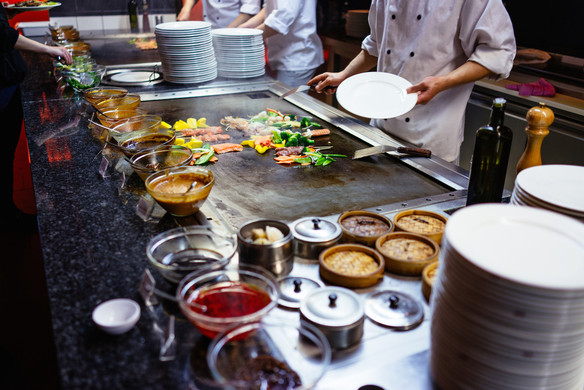Table of contents
When you run a restaurant, you’re met with daily decisions that can make or break your business. Are you stocked up for a busy weekend or burning cash on wasted ingredients? What happens when an unexpected repair bill lands on your plate?
“These decisions are real,” says Alvin Cailan of Amboy, in a conversation with Eric Wareheim for the Square-sponsored video series, “Running a Restaurant is No Joke.” “Some days, you think, ‘Should I get gas or pay an employee? Or should I buy green tomatoes?'” Alvin Cailan explains. “It’s tough for sure because product prices fluctuate so much nowadays. Everyone talks about supply chain issues, and for us, it’s real.”
With stakes that high, making blind decisions isn’t an option. The smart move is to tap into your restaurant data for intelligent decision-making. Over one-third of restaurant owners surveyed in the Square Future of Restaurants report said they plan to stay competitive by using data insights to better understand what their customers want.
How can you do this? Leverage your restaurant technology, which tracks nearly every aspect of your business, from daily transactions to customer loyalty. Your restaurant data can reveal your best-selling menu items, peak dining times, sales patterns, and more, empowering you to make informed, profitable decisions.
As you work to perfect aspects of your business, including your menu, inventory levels, or seasonal staffing, the data-driven approaches below can help you.
Optimize your menu based on sales data.
Your sales data is the first place to look for key information that can improve your menu’s appeal and profitability. Start by identifying your top-selling menu items over a significant period, say a month or a quarter. Square Point of Sale users can access this information readily on the Square Dashboard.
Top-performing menu items will let you know what’s important to keep or highlight on your menu. But don’t lose sight of the dishes that rarely get ordered. Low-performing menu items often take up your team’s time and resources.
While sales volume is a critical metric, it doesn’t paint the full picture. It’s important to gauge profitability versus popularity. A dish might be popular but have low profit margins, while a less frequently ordered item might be a high-margin offering. Analyze the cost of each menu item alongside its sales data to understand its profitability. This will help you strike the right balance between customer favorites and dishes that boost your bottom line.
For restaurants with multiple locations, Keegan Fong, founder of Woon Kitchen, stresses the importance of maintaining a consistent menu foundation across locations. “The goal is to take the core of the menu and keep it the same,” Keegan Fong says. This helps streamline operations, manage costs, and create a predictable experience for customers. “Scaling your ingredients will help in terms of cost efficiencies and bringing down the cost of ingredients and then adding on items that make sense based on that.”
Maximize inventory with real-time tracking and skilled talent.
Managing inventory is one of the trickiest balancing acts in the restaurant business. Stocking too little means you risk running out of key ingredients during service, frustrating customers, and losing sales. But overstocking ties up your cash in unused goods that may spoil before you get the chance to use them.
So, you need the right balance, and data is your best ally. Restaurant menu data can help uncover patterns in customer preferences, helping you predict demand. For instance, if demand for a specific dish spikes on weekends, you can ensure the necessary ingredients are always in stock and reduce the risk of running out.
With Square Inventory Management, you can monitor stock levels in real time, spot trends, and get alerts before a shortage or surplus becomes a problem. By connecting inventory data to sales trends, Square tools help you reduce waste, control costs, and keep your kitchen running smoothly so you can focus on the dining experience.
In addition to leveraging data, Cailan recommends hiring skilled people who intimately understand your ingredients. “What’s cool about what we do is that we’re chef-driven. I don’t hire cooks, I hire chefs. Everyone is super aware of what needs to get done for this to work.” Cailan believes this is crucial for making the most of your inventory.
“I think our secret sauce is our knowledge of the product. For example, when it comes to beef, even a little bit of waste can affect the entire operation. With accurate and skilled people, waste is minimized. That’s why I invest heavily in my team.”
Plan for seasonal staffing based on historical trends.
While the ebb and flow of restaurant traffic may seem random, you can spot patterns if you look closely at your data. Understanding these trends is key to making smarter staffing decisions, especially for seasonal periods, whether it’s holiday rushes, summer peaks, or unexpected local events.
Square Analytics gives you insight into seasonal sales trends, helping you anticipate busy times so you can plan accordingly. If your data shows a surge in dinner reservations leading up to Valentine’s Day, you can hire additional servers or bring in on-demand kitchen staff to handle the rush without committing to long-term hires.
Cailan emphasizes that no matter the season or staffing approach you take, delivering consistent service is essential. “Consistency is the most important thing—whether it’s the consistency in the quality of food or literally showing up at the same time every single day. The moment it’s inconsistent, customer service suffers, and you fall off,” Cailan explains.
By aligning staffing with sales data, you can optimize your team’s performance, reduce overhead, and consistently deliver excellent service all year round.
Prepare for unexpected expenses.
In the restaurant business, surprises are inevitable. It’s not a matter of if they’ll happen but when. A broken oven, a sudden plumbing issue, or an emergency restock can throw your budget into chaos if you’re unprepared. Studying your business data can help you plan ahead.
For example, analyzing past expenses might reveal that equipment repairs tend to spike during the summer months when air conditioning systems are overworked. Knowing this, you could proactively schedule maintenance or set aside funds for potential repairs.
Square Analytics includes detailed information on your sales data, trends, taxes, and service charges so you can monitor critical metrics and conduct proper financial analysis. Tracking your cash flow might reveal that slower sales in January make it harder to cover fixed costs, so you would need to set aside a larger reserve fund after the holiday season.
By analyzing your cash flow and profit margins, you can assess how equipped you are to handle unexpected costs. With this data, you can plan ahead, build an emergency fund, or secure additional resources before the next curveball hits.
Leverage customer feedback and data.
Sales data provides a quantitative look at what items perform well. But customer feedback offers qualitative insights that are just as crucial for improving your menu. Understanding how customers feel about your offerings can help you fine-tune every aspect of your menu, from flavor profiles to presentation.
In addition to public channels where customers provide feedback, like your website or social media, check your dedicated channels like Square Feedback, which allows you to collect private customer feedback from customers who opt for digital receipts. If multiple customers make the same complaint, like a meal being too spicy or lacking flavor, it may be a clear sign that you need to make adjustments.
Data from your loyalty programs and marketing tools can also help here. For example, customers get email or text notifications when they earn rewards via Square Loyalty and when you run marketing campaigns via Square Marketing. Checking which menu item notifications get the most engagement can help you understand what excites your community.
And don’t forget your customer demographics. Age, gender, and occupation, along with psychographic data regarding lifestyles, values, and interests, can also guide menu changes. For example, if your restaurant is popular with families, you may consider adding kid-friendly options. Square Customer Directory allows you to drill down on your customer data and understand their purchasing habits and preferences.
Implement menu changes based on data.
Once you’ve gathered insights from your sales data, demographic data, customer feedback, and trend analysis, the next step is to make those important changes.
While innovation keeps your menu dynamic and relevant, it’s essential to introduce new items thoughtfully to ensure they resonate with your customers. Consider introducing new dishes as specials or limited-time offers initially. This allows you to gather feedback and make adjustments before fully integrating them into your menu. Use your website, social media channels, and email marketing to create buzz around new menu items.
Removing items from your menu can be as crucial as adding new ones. Before making final decisions, discuss potential cuts with your kitchen and service staff. They might have valuable insights into why something isn’t selling or how it could be improved. If an item has a loyal following, communicate its removal in advance and consider offering it as an occasional special to maintain goodwill.
Grow your restaurant business with data-driven insights.
A well-optimized menu can unlock several benefits for your business, including higher profit margins, smoother kitchen operations, and more satisfied customers. By studying your restaurant’s data, you can make smart choices about what to keep, tweak, or remove from your menu. But it doesn’t stop with your menu. Your restaurant data plays a crucial role in other areas of your business. It enables you to manage inventory, anticipate seasonal staffing demands, and prepare for unexpected expenses.
Accessing the data you need doesn’t have to be complicated. Tools like Square Dashboard make it easy to track, analyze, and manage data from all areas of your business in one place so you can make critical decisions quickly and confidently.
So, don’t leave the success of your business to chance. Use your restaurant technology to dig into your business data and build a business as solid as your signature dish. Remember, the best decisions are the ones backed by numbers — and a little intuition.
![]()









